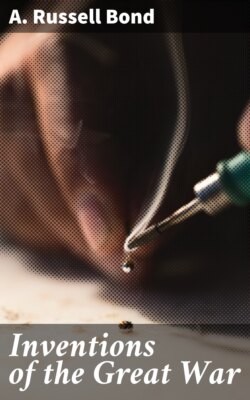Читать книгу Inventions of the Great War - A. Russell Bond - Страница 23
На сайте Литреса книга снята с продажи.
EFFECT OF OVERHEATING
ОглавлениеTable of Contents
But what if the gun-barrel does become hot? The real trouble is not that the cartridge will explode prematurely, but that the barrel will expand as it grows hot, so that the bullet will fit too loosely in the bore. Inside the barrel the bore is rifled; that is, there are spiral grooves in it which give a twist to the bullet as it passes through, setting it spinning like a top. The spin of the bullet keeps its nose pointing forward. If it were not for the rifling, the bullet would tumble over and over, every which way, and it could not go very far through the air, to say nothing of penetrating steel armor. To gain the spinning-motion the bullet must fit into the barrel snugly enough to squeeze into the spiral grooves. Now there is another American machine-gun known as the Hotchkiss, which was used to a considerable extent by the French Army. It is a gas-operated gun, something like the Colt, and it is air-cooled. It was found in tests of the Hotchkiss gun that in from three to four minutes of firing the barrel was expanded so much that the shots began to be a little uncertain. In seven minutes of continuous firing the barrel had grown so large that the rifling failed to grip the bullet at all. The gun was no better than an old-fashioned smooth-bore. The bullets would not travel more than three hundred yards. It is because of this danger of overheating that the Colt and the Hotchkiss guns are always furnished with a spare barrel. As soon as a barrel gets hot it is uncoupled and the spare one is inserted in its place. Our men are trained to change the barrel of a colt in the dark in a quarter of a minute.
But a gun that has to have a spare barrel and that has to have its barrel changed in the midst of a hot engagement is not an ideal weapon, by any means. And this brings us to still another invention—that, too, by an American. Colonel I. N. Lewis, of the United States Army, conceived of a machine-gun that would be cooled not by still air but by air in motion. This would do away with all the bother of water-jackets. It would keep the gun light so that it could be operated by one man, and yet it would not have to be supplied with a spare barrel.
Like the Colt and the Hotchkiss, the Lewis gun takes its power from the gas that comes through a small port in the barrel, near the muzzle. In the plate facing page 44 the port may be seen leading into a cylinder that lies under the barrel. It takes about one ten-thousandth part of a second for a bullet to pass out of the barrel after clearing the port, but in that brief interval there is a puff of gas in the cylinder which drives back a piston. This piston has teeth on it which engage a small gear connected with a main-spring. When the piston moves back, it winds the spring, and it is this spring that operates the mechanism of the gun. The cartridges, instead of being taken from a belt or a clip, are taken from a magazine that is round and flat. There are forty-seven cartridges in the magazine and they are arranged like the spokes of a wheel, but in two layers. As soon as forty-seven rounds have been fired, the shooting must stop while a new magazine is inserted. But to insert it takes only a couple of seconds.
